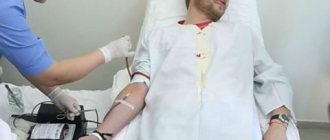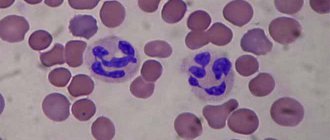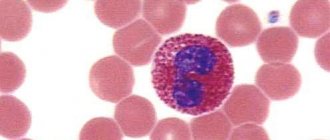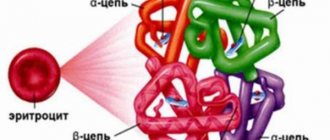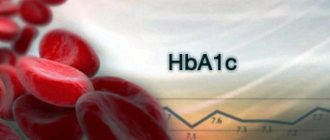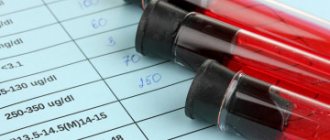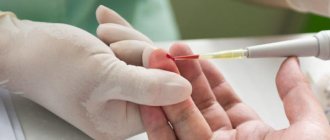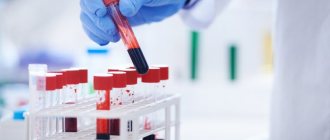The expression blue blood is familiar to many. Some people think that this is a synonym for the word - aristocrat, some think that this is just a metaphor and this is what they call privileged people who consider themselves a step above others, or those belonging to an eminent pedigree and endowed with power, but for some it is - a complete fabrication.
But nevertheless, science has proven that this expression has a basis. On our planet there really are people with blue blood, who differ from everyone else in a unique combination of genotype and this is more often found in those who have the fourth group with a negative Rh factor.
Why is human blood red?
Science knows that different living organisms on the planet have different blood colors.
However, in humans it is red. Why is blood red? This question is asked by both children and adults.
The answer is quite simple: the red color is due to hemoglobin, which contains iron atoms in its structure.
What makes blood red is hemoglobin, which consists of:
- From a protein called globin;
- The non-protein element heme, which contains the ferrous ion.
There are four hemes in hemoglobin molecules. Their number is 4 percent of the total mass of the molecule, and globin accounts for 96 percent.
The main effect in the activity of hemoglobin belongs to the iron ion.
Ferrous oxide makes blood red.
The metal that promotes the reproduction of red blood cells is continuously produced by the human body.
Nitric oxide, in turn, plays an important role in regulating blood pressure.
Types of blood
| Arterial | Venous |
| Rich in oxygen, comes from the heart. A bright scarlet hue distinguishes arterial blood from venous blood. | Gives oxygen to organs and returns to the heart. The dark red tint is a distinctive feature. What makes this blood dark is the carbon dioxide that fills it. |
About the color of blood
Blood is a liquid, the fluidity of which is determined by its viscosity and the nature of the movement of its components. Blood viscosity depends on the number of red blood cells and proteins it contains, and affects the speed of blood flow and blood pressure.
Blood consists of pale yellow plasma, which contains three types of cellular elements: red blood cells (erythrocytes), white cells (leukocytes), and platelets (platelets). The total volume of blood in the body of an adult male is about five liters, with most of it being plasma and the rest mostly red blood cells. Red blood cells contain the pigment hemoglobin, which gives blood its red color.
The main function of red blood cells is to transport oxygen, and hemoglobin plays a key role in this process. Hemoglobin is an organic pigment that contains a compound of porphyrin with iron (heme) and the protein globin.
It is known that the blood in the arteries and veins has different shades: venous blood is dark, arterial blood is bright scarlet. This happens because the arteries carry blood from the heart and lungs and are saturated with oxygen. And through the veins, blood from tissues and organs flows to the heart; the hemoglobin in this blood is almost devoid of oxygen, which is why it has a dark color.
Compound
Blood is a rapidly renewing connective tissue that continuously circulates throughout the human body.
It was possible to find out what gives the red color, but its elements turn out to be no less interesting. What elements give it this color is an equally interesting aspect.
Blood contains:
- Plasma. The liquid is light yellow in color, with its help the cells in its composition can move. It is composed of 90 percent water, with the remaining 10 percent made up of organic and inorganic components. Plasma also contains vitamins and microelements. The light yellow liquid contains many useful substances.
- The formed elements are blood cells. There are three types of cells: white blood cells, platelets and red blood cells. Each type of cell has certain functions and characteristics.
Leukocytes
These are white cells that protect the human body. They protect it from internal diseases and foreign microorganisms penetrating from the outside.
Leukocytes
This is a white element in color. Its white tint cannot be ignored during laboratory tests, so such cells are identified quite simply.
White blood cells recognize foreign cells that can cause harm and destroy them.
Platelets
These are very small colored plates whose main function is coagulation.
Platelets
These cells are responsible for ensuring that the blood:
- It coagulated and did not flow out of the body;
- Coagulates quite quickly on the surface of the wound.
Red blood cells
More than 90 percent of these cells are in the blood. It is also red because red blood cells have this hue.
Red blood cells
They carry oxygen from the lungs to peripheral tissues and are continuously produced in the bone marrow. They live for about four months, then are destroyed in the liver and spleen.
It is very important for red blood cells to carry oxygen to various tissues of the human body.
Few people know that immature red blood cells are blue, then acquire a gray tint and only then turn red.
There are quite a lot of human red blood cells, which is why oxygen reaches peripheral tissues so quickly.
It is difficult to say which element is more significant. Each of them has an important function that affects human health.
Video - Secrets and mysteries of our blood
Why is blood red?
- Blood is red because heme is red, that's all. Nature simply works in such a way that complex compounds of transition metals with organic and inorganic substances usually have some kind of color. For example, many complex compounds of divalent copper are colored dark blue; a complex compound of ferric iron with cyanide in an aqueous solution is yellow in color, and with thiocyanate it is red. And the complex compound of ferrous iron with porphyrin (heme) is colored red. This is how the distribution of valence electrons of this compound among energy levels developed. And it so happened that it is heme that is able to reversibly add molecular oxygen (without the formation of iron oxide!) and carbon oxides, and its red color is only indirectly related to this property. To convert heme iron into oxide, the heme must be irreversibly destroyed. Ferrous oxide is black, insoluble in water and incapable of giving up oxygen just like that. If BestFriend believes that by binding to oxygen, heme iron is oxidized to trivalent iron, then this is also not true. Ferric oxide has a brown-red (or brick-red) color, closer to the color of venous blood, while oxygen-enriched hemoglobin is bright scarlet. Ferric oxide is also insoluble in water, and is also incapable of giving up oxygen just like that. And also, for it to form, heme must be irreversibly destroyed. And the transformation of heme iron into trivalent iron (occurs in some poisonings) leads to the loss of heme’s ability to carry oxygen. Let me emphasize that oxygen bound in a complex with hemoglobin retains its molecular form, without oxidizing anything in hemoglobin.
The fact is that blood contains red blood cells. They, in turn, carry oxygen throughout the body. And the fact is that red blood cells or hemoglobin contain, or rather contain, divalent iron, which attaches oxygen and, together with hemoglobin, is carried by the blood to nourish the cells. But the iron salts in hemoglobin are red in color. and it is arterial blood that is rich in oxygen and brighter in color, while venous blood is darker. Of course, this process is very complex to be explained only from a chemistry perspective. But everyone knows that those who have little hemoglobin in their blood need to consume foods rich in iron.
In order to understand why blood is red, you need to understand its composition.
Blood consists of plasma and formed elements: leukocytes, platelets and erythrocytes.
Leukocytes and platelets are colorless.
Red blood cells contain hemoglobin, a red pigment that gives blood its red color.
BestFriend explained everything correctly, all that remains is to add what he kept silent about.
Hemoglobin is contained in special blood cells - red blood cells. This is a necessary condition for the transfer of oxygen into the cells of the body and its release for the oxidation of nutrients (ultimately, obtaining energy for life). Outside of red blood cells, hemoglobin is able to bind oxygen, but gives it away very reluctantly, only under the influence of enzymes. But why reinvent the wheel if all the necessary conditions have already been created in red blood cells?
It is red blood cells that give blood its red color. Especially the arterial one, which is enriched with oxygen (it is bright red and opaque). But venous blood, if you look at it in a test tube, looks like cherry jam diluted with water. The secret of the trick is simple: red blood cells, having given oxygen to the cells, lose color, and also somewhat decrease in size, and go through the veins quot;to the second circlequot; - for a new portion of oxygen from the lungs.
Therefore, anyone can distinguish arterial bleeding from venous bleeding: bright red blood comes from an artery, dark red blood comes from a vein.
The leaves could have been of other colors if not for an accident during their evolution. There are also non-green plants in the world, but it just so happens that it is the green ones that have spread.
And blood doesn’t have to be red either, blue also exists, due to the content
Blood plays the role of a transportation system in our body. When pumped by the heart, blood delivers oxygen from the air we breathe, and all the nutrients from the food we eat, to all the cells of the body.
Blood also keeps cells clean and healthy by carrying away waste products from cells that are produced after oxygen and nutrients are used. To regulate various processes in our body, glands produce hormones, and it is the blood that carries these hormones throughout the body. Blood also carries heat throughout the body. A watery liquid like plasma
– makes up more than half of the blood in the body. Plasma contains metabolic products, nutrients, and also substances and chemical compounds that are so necessary for blood clotting.
Tiny cells make up the rest of the blood. erythrocytes carry oxygen throughout the body and carry carbon dioxide out of the lungs
.
White blood cells - leukocytes
, are the remaining elements of blood.
Leukocytes destroy pathogens that enter our body, thereby protecting us from all kinds of infections. Although red blood cells are the smallest cells in our body, a drop of blood contains approximately 5 million red blood cells, 10 thousand white blood cells, and 250 thousand platelets. Platelets
are responsible for forming a blood clot at the site where the blood vessel is damaged. There are only four blood groups: 0, A, B, AB. Every person's blood belongs to one of these groups.
The protein found in the blood is called hemoglobin. Hemoglobin is found in red blood cells and contains iron, and because of this, our blood is red. Sometimes our blood is dark red, and sometimes it is bright red. Changing the amount of oxygen in our blood explains the difference in color.
Types of blood vessels called arteries carry blood from the heart and lungs to the rest of the organs. Such blood is saturated with oxygen, which, when combined with hemoglobin, gives the blood its bright red color.
Science knows that different living organisms on the planet have different blood colors.
However, in humans it is red. Why is blood red? This question is asked by both children and adults.
The answer is quite simple: the red color is due to hemoglobin, which contains iron atoms in its structure.
What makes blood red is hemoglobin, which consists of:
- From a protein called globin;
- The non-protein element heme, which contains the ferrous ion.
It was possible to find out what gives the red color, but its elements turn out to be no less interesting. What elements give it this color is an equally interesting aspect.
Blood contains:
- Plasma.
The liquid is light yellow in color, with its help the cells in its composition can move. It is composed of 90 percent water, with the remaining 10 percent made up of organic and inorganic components. Plasma also contains vitamins and microelements. The light yellow liquid contains many useful substances. - The formed elements are blood cells.
There are three types of cells: white blood cells, platelets and red blood cells. Each type of cell has certain functions and characteristics.
These are white cells that protect the human body. They protect it from internal diseases and foreign microorganisms penetrating from the outside.
This is a white element in color. Its white tint cannot be ignored during laboratory tests, so such cells are identified quite simply.
White blood cells recognize foreign cells that can cause harm and destroy them.
These are very small colored plates whose main function is coagulation.
These cells are responsible for ensuring that the blood:
- It coagulated and did not flow out of the body;
- Coagulates quite quickly on the surface of the wound.
More than 90 percent of these cells are in the blood. It is also red because red blood cells have this hue.
They carry oxygen from the lungs to peripheral tissues and are continuously produced in the bone marrow. They live for about four months, then are destroyed in the liver and spleen.
It is very important for red blood cells to carry oxygen to various tissues of the human body.
Few people know that immature red blood cells are blue, then acquire a gray tint and only then become red.
There are quite a lot of human red blood cells, which is why oxygen reaches peripheral tissues so quickly.
It is difficult to say which element is more significant. Each of them has an important function that affects human health.
Children often ask questions regarding the components of the human body. Blood is one of the most popular topics of discussion.
Explanations for children should be extremely simple, but at the same time informative. Blood contains many substances that differ in function.
Consists of plasma and special cells:
- Plasma is a liquid that contains useful substances. It has a light yellow tint.
- The formed elements are erythrocytes, leukocytes and platelets.
The presence of red cells - erythrocytes - explains its color. Red blood cells are red by nature, and their accumulation leads to the fact that a person’s blood is exactly this color.
There are about thirty-five billion red cells that move throughout the human body in the blood vessels.
Explanation for the child
Children often ask questions regarding the components of the human body. Blood is one of the most popular topics of discussion.
Explanations for children should be extremely simple, but at the same time informative. Blood contains many substances that differ in function.
Consists of plasma and special cells:
- Plasma is a liquid that contains useful substances. It has a light yellow tint.
- The formed elements are erythrocytes, leukocytes and platelets.
The presence of red cells - erythrocytes - explains its color. Red blood cells are red by nature, and their accumulation leads to the fact that a person’s blood is exactly this color.
There are about thirty-five billion red cells that move throughout the human body in the blood vessels.
Why are veins blue
The veins carry burgundy blood. They are red, like the color of the blood that flows through them, but not blue. The veins only appear blue.
This can be explained by the law of physics about the reflection of light and perception:
When a ray of light hits the body, the skin reflects some of the waves and looks light. However, it transmits the blue spectrum much worse.
The blood itself absorbs light of all wavelengths. The skin gives a blue color for visibility, and the vein is red.
The human brain compares the color of the blood vessel against the warm tone of the skin, resulting in blue.
Blood of a different color in various living creatures
Not all living organisms have red blood.
The protein that gives this color in humans is hemoglobin, contained in hemoglobin. Other living beings have other fat-containing proteins instead of hemoglobin.
The most common shades besides red are:
- Blue. Crustaceans, spiders, mollusks, octopuses and squids boast this color. And blue blood is of great importance for these creatures, as it is filled with important elements. Instead of hemoglobin, it contains hemocyanin, which contains copper.
- Violet. This color is found in marine invertebrates and some mollusks. Typically, such blood is not only purple, but also slightly pink. The blood of young invertebrate organisms is pink. In this case, the protein is hemerythrin.
- Green. Found in annelids and leeches. The protein is chlorocruorin, close to hemoglobin. However, iron in this case is not oxide, but ferrous.
The color of blood varies depending on the protein it contains. Whatever the color of blood, it contains a huge amount of useful substances necessary for a living organism. Pigment is important for every organism, despite its diversity.
Source: medpath.ru
Red blood cells and their designation in the blood test form
The structure of red blood cells is determined by their main function - the transport of hemoglobin through blood vessels. The biconcave shape, small size and elasticity ensure the passage of particles even in the narrowest capillaries.
The key task of red blood cells, as we have already noted, is directly related to the hemoglobin they contain. This protein has the ability to bind with oxygen and carbon dioxide, transporting the first to tissues and organs, and the second back to the lungs. Each red blood cell contains 270–400 million hemoglobin molecules.
Before turning into a full-fledged cell, an erythrocyte goes through several stages of development. First, a megaloblast is formed in the red bone marrow, then it transforms into an erythroblast and a normocyte, subsequently turning into a reticulocyte, a form that precedes a mature red blood cell.
The content of red blood cells in the blood differs between men and women. Also, these indicators depend on age.
Normal concentration of red blood cells in the blood
For newborns, indicators of 3.9–5.9 million/μl are typical. In children from 1 to 12 years old, the normal level of red blood cells in the blood is 3.8–5 million/μl. With age, gender differences come into force - for boys 12–18 years old, normal red blood cell counts should range from 4.1 to 5.6 million/μl, and for girls - from 3.8 to 5.1. The blood of adult men usually contains 4.3–5.8 million cells per microliter, women - 3.8–5.2. The body of pregnant women has its own characteristics; during this period it actively accumulates fluid, which means the composition of the blood undergoes significant transformations. Therefore, it is normal for expectant mothers to experience a slight decrease in red blood cell levels.
A change in the number of red blood cells in a person’s blood can indicate both the presence of a disease and certain conditions of the body.
What does an increased level of red blood cells in the blood mean?
Doctors call a high level of red blood cells erythrocytosis. Often the reason for an increase in the number of red blood cells in a person’s blood is dehydration resulting from natural causes, as well as from diarrhea, vomiting, and high fever. Therefore, by the way, it is not recommended to undergo analysis after heavy physical exertion. In addition, an increased level of red blood cells in the blood may be characteristic of vitamin deficiency, as well as for residents of high mountainous regions and people whose profession is related to air travel.
Pathological causes of elevated red blood cell levels include diseases such as cardiovascular or respiratory failure, as well as polycystic kidney disease and erythremia.
Red blood cell count is below normal
By analogy with an increased level of red blood cells, a decrease in the number of these cells can be caused by overhydration, that is, excessive saturation of tissues with fluid. The presence of cancerous tumors with metastases, chronic inflammation, as well as any type of anemia can also cause a low level of red blood cells in the patient’s blood. Less commonly, it is a matter of various malfunctions of the immune system, when the human body begins to produce antibodies to red blood cells, independently destroying them.
Disturbances in the functioning of the red bone marrow, where “young” cells are formed, sometimes cause a decrease in the level of reticulocytes in the blood; in addition, this phenomenon can be caused by aplastic and hypoplastic anemia.
Pathologies of red blood cell shape
Some types of anemia (for example, hemolytic) can provoke a predominance of red blood cells of reduced size (the diameter of one cell is less than 6.5 microns) - this phenomenon is called microcytosis. The small size of red blood cells can cause the accumulation of water in the cell, as a result of which its shape changes, becoming more and more round.
Spherocytosis, that is, the predominance of spherical cell shapes, makes the red blood cell much more vulnerable and reduces its ability to penetrate narrow blood vessels. This is a genetic pathology that is inherited. Just like elliptocytosis, the disease causes the destruction of red blood cells when they enter the spleen.
Patients with anorexia and severe liver damage may develop acanthocytosis, which is characterized by the appearance of various growths from the cytoplasm of the cell. And with significant poisoning of the body by toxins and poisons, echinocytosis manifests itself, that is, the presence of a large number of jagged red blood cells.
Codocytosis, or the appearance of target cells, is associated with increased cholesterol levels in the red blood cell. A light “ring” forms inside the cell; this may be a sign of liver disease and prolonged obstructive jaundice.
When cells are saturated with abnormal hemoglobin, the risk of developing a disease such as sickle cell anemia increases. The presence of crescent-shaped red blood cells in the blood rarely threatens the patient’s health, but can cause serious illnesses in the offspring, especially if both parents have this sign.
Change in hemoglobin level
The functions of red blood cells, as already mentioned, are inextricably linked with hemoglobin, a complex iron-containing protein. In newborn children, the normal concentration of this substance is 145–225 g/l, and at the age of 3–6 months it decreases to 95–135 g/l, then as they grow older it approaches the standard norm - for men 130–160 g/l , and for women 120–150 g/l.
During pregnancy, a woman’s body actively accumulates fluid, so the hemoglobin level may be lowered (110–155 g/l), which is a consequence of some “dilution” of the blood.
With significant blood loss, exhaustion, hypoxia, kidney and bone marrow diseases, a decrease in the level of hemoglobin in the blood is observed. This condition may be associated both with the disappearance of hemoglobin and with a deterioration in its ability to bind oxygen to cells.
Elevated hemoglobin levels can be caused by congenital heart disease, pulmonary fibrosis, and impaired renal hormone production. Often, you can observe excessive blood thickness; it becomes difficult for it to move through the blood vessels.
Deviation of ESR from reference values
Erythrocyte sedimentation rate is an indicator that is one of the components of a general blood test. The essence of the method is to measure the amount of time it takes for red blood cells to settle to the bottom of the vessel under the influence of gravity. If the blood contains proteins, the presence of which indicates inflammatory processes in the body, the erythrocyte sedimentation rate will occur faster.
In children under 10 years of age, ESR should not exceed 10 mm/h; for women, the normal value is 2–15 mm/h, and for men, 1–10 mm/h. Changes in protein fractions in the body of a pregnant woman can cause an increased ESR (up to 45 mm/h), which is not a consequence of inflammatory processes. In other cases, elevated levels may be a sign of infectious diseases, anemia, the presence of cancer, myocardial infarction and autoimmune diseases.
Red blood cell indices discrepancy
In order to systematize the various characteristics of red blood cells, scientists have developed so-called red blood cell indices.
Mean erythrocyte volume (MCV) - in adult men and women, this figure should be between 80 and 95 fl. For newborns, the upper limit is allowed to be exceeded - up to 140 fl, and for children from 1 year to 12 years, the reference value is 73-90 fl. Violation of the upper limit can be a consequence of hemolytic anemia, liver disease and vitamin B12 deficiency. A significant decrease in MCV levels indicates dehydration, thalassemia or lead poisoning.
Hemoglobin content in an erythrocyte (MCH ) - in newborns up to 2 weeks of age, this indicator ranges from 30 to 37 pg, and then as they grow older it approaches the usual norm of 27–31 pg. Increased levels are observed in certain types of anemia, hypothyroidism, liver disorders and cancer. A decrease in the amount of hemoglobin in a red blood cell may be a consequence of hemoglobinopathy, lead intoxication, or a lack of vitamin B6.
The mean hemoglobin concentration in red blood cells (MCHC ) shows the saturation of each cell with hemoglobin. In adult men and women, this figure is usually 300–380 g/l, in babies up to 1 month it can be slightly lower and amount to 280–360 g/l, and for children under 12 years of age the values are within the range of 290–380 g/l. l. Elevated MCHC is a frequent accompaniment of impaired water-electrolyte metabolism, some forms of thalassemia and pathologies of erythrocyte forms. And lower values can be a companion to iron deficiency anemia.
RDW, or red blood cell distribution width , is measured as a percentage and shows how heterogeneous the cells are in terms of volume. For adults, normal values are 11.6-14.8%, and for children under 6 months - 14.9-18.7%. In liver disease and anemia, RDW may be higher than normal, and a decrease in level often indicates an error in the analyzer.
The study of red blood cells is only a fragment of a general (clinical) blood test, but it can also tell the doctor a lot about the functioning of the body. However, every doctor will tell you that only in combination with other indicators can an analysis of red blood cells give a reliable diagnostic result.
Source: www.eg.ru
Different color of blood during menstruation: what does it mean?
The menstrual cycle is a very important part of women’s health, and by its regularity, length, and discharge, you can learn a lot about your state of health, primarily about the functioning of the reproductive organs.
Menstrual blood can be different colors: bright red, brownish, black and even orange.
While most color variations may be considered normal or healthy, some may be signs of serious health problems and warrant a visit to your doctor.
Important! If you notice blood of an unusual color at any time during your cycle, you should consult a gynecologist for advice.
Normal menstrual blood comes in black, brown, dark red, bright red, pink and orange.
1Brown spotting
Brown spotting of all shades during menstruation is a sign of “old blood”: it was red, but simply oxidized due to the fact that the discharge was not too abundant and it took a long time to leave the uterus.
Brown blood may be due to:
- the beginning and end of menstruation
- lochia
- pregnancy (a sign of stopped bleeding: urgently need to see a doctor!)
- frozen pregnancy (you must urgently consult a doctor)
2Dark red blood
Dark red blood often occurs after you wake up or move around after sitting or lying down for a long time
A dark color may mean that the blood has simply been in the uterus for a long time, but not long enough to oxidize and turn brown.
That’s why women’s blood often darkens towards the end of menstruation, when the amount of bleeding decreases.
Dark red color of blood is characteristic of:
- last days of menstruation
- lochia
3Bright red blood
Bright red blood often occurs at the beginning of menstruation, when bleeding is most intense.
The color of the blood may be the same throughout the entire period of menstrual bleeding or become darker towards the end.
Bright red blood color may also be due to:
- infections - for example, with chlamydia or gonorrhea, there is bleeding between menstruation; if you see bleeding before the expected onset of menstruation, it is better to consult a gynecologist for advice.
- pregnancy - if you are pregnant and notice bloody discharge, you should consult your doctor to rule out a miscarriage, pathology or infection.
- polyps and fibrosis - these non-carcinogenic neoplasms can cause intense periods or bleeding in other phases of the menstrual cycle, as well as cause a feeling of pressure inside and pain; consultation with a gynecologist is necessary.
4Pink color of blood
Menstrual blood may be pink at the beginning or end of your period, especially if you have spotting
A light shade most likely means that the blood has simply mixed with cervical secretions, simply making the color of the blood less intense.
Pink and light red blood colors can also be associated with:
- postpartum bleeding (lochia)
- low estrogen levels
- bloody spotting in the middle of the cycle during ovulation
- miscarriage
- bloody discharge after fertilization of the egg
5Orange
When blood mixes with cervical discharge, it can also have an orange tint, so the reasons for the appearance of blood of this color are the same as those for pink and light red discharge.
Orange blood color may also be due to:
- spotting after fertilization of the egg - some women notice orange or light red and pink spotting soon after fertilization or 10-14 days after fertilization. This does not happen to all women, but if you notice spotting that does not develop into menstruation, then it makes sense to take a pregnancy test.
- Infections – Any unusual color of discharge may be a sign of a bacterial infection or STD.
6Gray
Gray blood color may be due to:
- infections - this shade may mean you have a bacterial infection. Other signs of infection include fever, pain, foul odor and itching.
- miscarriage - if you are pregnant, this color of discharge may be associated with a miscarriage.
Important! If you notice gray or off-white bleeding, you should consult a gynecologist.
7Black
Despite the fact that black blood looks scary, it is not necessarily a sign of a pathological process in the body.
The blood that slowly left the uterus turns black. This discharge may look like coffee grounds and be gelatinous.
Infections such as gonorrhea and chlamydia can cause bleeding between periods
If you see blood before the approximate start date of your period, it makes sense to see a doctor.
During pregnancy, bleeding may or may not be a cause for concern. Sometimes this can be a sign of a miscarriage, sometimes not: every case is unique , so you should see your doctor whenever you experience any bleeding during pregnancy.
Another cause of heavy bleeding during menstruation or other phases of the menstrual cycle can be polyps or fibrosis. These benign growths can cause these symptoms, as well as pressure and pain.
Important! If you notice any unusual discharge from the vagina, be it blood or not, during menstruation or not, then it is better not to worry yourself by looking for possible causes on the Internet, but to consult a professional doctor for advice.
Any unusual discharge (unusual structure, smell, or occurring at an unusual time) may be signs of infections and sexually transmitted diseases. Take care of your health, you only have one and remember: it is easier and easier to treat any disease if treatment is started as early as possible after it is discovered!
Source: https://Kotex.ru/blog/cut-mesyachnykh/raznyy-tsvet-krovi-na-protyazhenii-menstruatsii-chto-eto-znachit
Why is human blood red?
Science knows that different living organisms on the planet have different blood colors.
However, in humans it is red. Why is blood red? This question is asked by both children and adults.
The answer is quite simple: the red color is due to hemoglobin, which contains iron atoms in its structure.
What makes blood red is hemoglobin, which consists of:
- From a protein called globin,
- The non-protein element heme, which contains the ferrous ion.
There are four hemes in hemoglobin molecules.
Their number is 4 percent of the total mass of the molecule, and globin accounts for 96 percent. The main effect in the activity of hemoglobin belongs to the iron ion.
Ferrous oxide makes blood red.
The metal that promotes the reproduction of red blood cells is continuously produced by the human body.
Nitric oxide, in turn, plays an important role in regulating blood pressure.
Types of blood
| Arterial | Venous |
| Rich in oxygen, comes from the heart. A bright scarlet hue distinguishes arterial blood from venous blood. | Gives oxygen to organs and returns to the heart. The dark red tint is a distinctive feature. What makes this blood dark is the carbon dioxide that fills it. |
What color are blood and veins really?
Human blood is not just a liquid. It contains a lot of different elements that distribute nutrients throughout the body and fill our tissues with oxygen. Most of our blood consists of plasma, in which blood cells (formed elements) are suspended, and any substances that are carried (besides oxygen) dissolve here.
Plasma is the most important component of this important liquid and is very pale in color with a yellow tint. But as soon as the formed elements dissolve in it, it sharply changes its color and becomes slightly cloudy. The most common type of blood cell found in plasma is red blood cells, which contain a protein called hemoglobin.
Shoes, sundress, silk: my New Year's look. What were the first 3 words you saw?
The divers were ready to dive. But the seals had their own plans
Roman listened to the nurses' conversation in the hospital and decided to take a DNA test
There's so much you can't find on the net. Even the question about the color of blood and veins is often accompanied by assumptions and fiction, although most people actually know the answer. Yes, everything is simple here - the blood is red, only in different shades, depending on the amount of hemoglobin in it and oxygen enrichment.
Everything is as taught in biology and BJD at school: arterial blood (rich in oxygen, coming from the heart) is bright scarlet, and venous blood (which has given oxygen to the organs, returning to the heart) is dark red (burgundy). The veins that are visible under the skin are also red when blood flows through them inside. After all, the blood vessels themselves are quite transparent. But still, many people have questions such as “Why does blood come in different colors and what does this depend on?” and “Why are veins blue or cyan?”
The red color of blood can have different shades. Oxygen carriers, i.e. red blood cells (erythrocytes), are a shade of red depending on hemoglobin, an iron-containing protein found in them that can bind with oxygen and carbon dioxide to carry them to the desired location.
The more oxygen molecules connected to hemoglobin, the brighter the red color the blood is. That’s why arterial blood, which has just been enriched with oxygen, is so bright red. After the release of oxygen to the cells of the body, the color of the blood changes to dark red (burgundy) - such blood is called venous.
Of course, the blood contains other cells besides red blood cells. These are also leukocytes (white blood cells) and platelets. But they are not in such significant quantities compared to red blood cells as to affect the color of the blood.
Compound
Blood is a rapidly renewing connective tissue that continuously circulates throughout the human body.
It was possible to find out what gives the red color, but its elements turn out to be no less interesting. What elements give it this color is an equally interesting aspect.
Blood contains:
- Plasma. The liquid is light yellow in color, with its help the cells in its composition can move. It is composed of 90 percent water, with the remaining 10 percent made up of organic and inorganic components. Plasma also contains vitamins and microelements. The light yellow liquid contains many beneficial substances.
- Formed elements of blood cells. There are three types of cells: white blood cells, platelets and red blood cells. Each type of cell has certain functions and characteristics.
Leukocytes
These are white cells that protect the human body. They protect it from internal diseases and foreign microorganisms penetrating from the outside.
Leukocytes
This is a white element in color. Its white tint cannot be ignored during laboratory tests, so such cells are identified quite simply.
White blood cells recognize foreign cells that can cause harm and destroy them.
Platelets
These are very small colored plates whose main function is coagulation.
Platelets
These cells are responsible for ensuring that the blood:
- It coagulated and did not flow out of the body,
- Coagulates quite quickly on the surface of the wound.
Red blood cells
More than 90 percent of these cells are in the blood. It is also red because red blood cells have this hue.
Red blood cells
They carry oxygen from the lungs to peripheral tissues and are continuously produced in the bone marrow. They live for about four months, then are destroyed in the liver and spleen.
It is very important for red blood cells to carry oxygen to various tissues of the human body.
Few people know that immature red blood cells are blue, then acquire a gray tint and only then turn red.
There are quite a lot of human red blood cells, which is why oxygen reaches peripheral tissues so quickly.
It is difficult to say which element is more significant. Each of them has an important function that affects human health.
Platelets
Blood platelets running near the walls of blood vessels. They act as if in the form of permanent repair teams that monitor the serviceability of the vessel walls. There are more than 500 thousand of these repairmen in every cubic millimeter. And in total there are more than one and a half trillion in the body.
The lifespan of a certain group of blood cells is strictly limited. For example, red blood cells live for about 100 days. The life of leukocytes ranges from several days to several decades. Platelets live the shortest. They only exist for 4-7 days.
Together with the blood flow, all these elements move freely throughout the circulatory system. Where the body keeps a measured blood flow in reserve - this is in the liver, spleen and subcutaneous tissue, these elements can stay here longer.
Each of these travelers has their own specific start and finish. They cannot avoid these two stops under any circumstances. The beginning of their journey is also where the cell dies.
It is known that a larger number of blood elements begin their journey leaving the bone marrow, some begin in the spleen or lymph nodes. They end their journey in the liver, some in the bone marrow or spleen.
Within a second, about 10 million red blood cells are born, and the same amount falls on dead cells. This means that construction work in the circulatory system of our body does not stop for a second.
The number of such red blood cells can reach up to 200 billion per day. In this case, the substances that make up the dying cells are processed and used again when recreating new cells.
Explanation for the child
Children often ask questions regarding the components of the human body. Blood is one of the most popular topics of discussion.
Explanations for children should be extremely simple, but at the same time informative. Blood contains many substances that differ in function.
Consists of plasma and special cells:
- Plasma is a liquid that contains useful substances. It has a light yellow tint.
- The formed elements are erythrocytes, leukocytes and platelets.
The presence of red erythrocyte cells explains its color. Red blood cells are red by nature, and their accumulation leads to the fact that a person’s blood is exactly this color.
There are about thirty-five billion red cells that move throughout the human body in the blood vessels.
Morbidity by blood type
People with different blood groups are susceptible to certain diseases. For example, a person with the first blood group is susceptible to peptic ulcers of the stomach and duodenum, gastritis, and bile disease.
Diabetes mellitus is very often and more difficult for individuals with the second blood group. In such people, blood clotting is significantly increased, which leads to myocardial infarction and stroke. If you follow the statistics, such people experience genital cancer and stomach cancer.
Persons with the third blood group suffer more than others from colon cancer. Moreover, people with the first and fourth blood groups have a hard time with smallpox, but are less susceptible to plague pathogens.
Why are veins blue
The veins carry burgundy blood. They are red, like the color of the blood that flows through them, but not blue. The veins only appear blue.
This can be explained by the law of physics about the reflection of light and perception:
When a ray of light hits the body, the skin reflects some of the waves and looks light. However, it transmits the blue spectrum much worse.
The blood itself absorbs light of all wavelengths. The skin gives a blue color for visibility, and the vein is red.
The human brain compares the color of the blood vessel against the warm tone of the skin, resulting in blue.
Blood of a different color in various living creatures
Not all living organisms have red blood.
The protein that gives this color in humans is hemoglobin, contained in hemoglobin. Other living beings have other fat-containing proteins instead of hemoglobin.
The most common shades besides red are:
- Blue. Crustaceans, spiders, mollusks, octopuses and squids boast this color. And blue blood is of great importance for these creatures, as it is filled with important elements. Instead of hemoglobin, it contains hemocyanin, which contains copper.
- Violet. This color is found in marine invertebrates and some mollusks. Typically, such blood is not only purple, but also slightly pink. The blood of young invertebrate organisms is pink. In this case, the protein is hemerythrin.
- Green. Found in annelids and leeches. The protein chlorocruorin is close to hemoglobin. However, iron in this case is not oxide, but ferrous.
The color of blood varies depending on the protein it contains. Whatever the color of blood, it contains a huge amount of useful substances necessary for a living organism. Pigment is important for every organism, despite its diversity.
Source: KardioBit.ru
Chemistry of colorful blood
What color is bloody? For most, the color of blood is associated with red. Red blood is familiar and obvious.
However, red is not the only possible blood color. Blood can be blue, green, purple, and even colorless - all due to specific chemicals that make up the blood in different organisms.
Hemoglobin and red color of blood
Most people know that human blood, like most other vertebrates, is red due to hemoglobin, which contains iron atoms in its structure.
Hemoglobin is also known as the respiratory pigment, and it plays an important role in the body, transporting oxygen throughout the body to our cells, and also helps take carbon dioxide from the tissues and “throw it back” into the lungs.
The large protein hemoglobin is made up of four small blocks that contain small regions called hemes, each containing an iron atom.
Heme, which contains a divalent iron atom that can attach or donate an oxygen molecule. In this case, the valence of iron, to which oxygen is attached, does not change.
It is thanks to this divalent iron oxide (Fe2) that hemoglobin acquires its red color. All vertebrates, some species of insects and mollusks have iron oxide in their blood protein, and therefore their blood is red.
Blood of a different color
Red is not the only blood color possible in nature. And this is due to the fact that some living beings’ red blood cells contain not hemoglobin, but other iron-containing proteins.
Purple Blood
This is observed in some species of invertebrates, in particular mollusks.
Their blood contains the protein hemerythrin, which is a respiratory pigment in the blood and contains five times more iron than hemoglobin. Hemerythrin, saturated with oxygen, gives the blood a purple tint, and when it gives oxygen to the tissues, such blood becomes pink.
Green blood
Another iron-containing protein, chlorocruorin, gives blood and tissue fluid a green color. This protein is dissolved in the blood plasma and is close in composition to hemoglobin, but the iron in it is not oxide, as in the blood of mammals, but ferrous. That's why the color turns out green.
Blue blood
However, the color range of the blood of living beings is not limited to red, purple and green. For example, octopuses, octopuses, spiders, crabs and scorpions are blue bloods in the most literal sense. The reason is that in these animals and insects the respiratory pigment of the blood is not hemoglobin, but hemocyanin, which contains copper (Cu2) instead of iron.
Causes of development and principles of treatment of macrocytic anemia
Blood is the main fluid of the internal environment of the human body. It performs many functions, ensuring homeostasis. A large group of pathologies are blood diseases, and in particular anemia, characterized by a decrease in hemoglobin concentration, which is accompanied by a decrease in the number of red blood cells. Although anemia is not an independent disease, but is only a syndrome, in severe cases it is fraught with dangerous consequences for health. Macrocytic anemia is a pathology characterized not only by a decrease in hemoglobin content in the blood, but also by an increase in the size of red blood cells, as well as their rapid death.
Reasons for the development of pathology
Anemia can occur for many reasons. Among the main etiological factors of the macrocytic form of the disease are:
- Lack of vitamin cyanocobalamin and folic acid. These substances play an important role in the process of hematopoiesis. Their content in the human body can decrease if there is insufficient intake from food, as well as if their absorption in the digestive tract is impaired, which often develops with gastrointestinal disorders and infections.
- Oncological and toxic liver lesions. This organ is the most important blood depot, and anemia is the first manifestation of its dysfunction. Hepatopathy against the background of cancer is accompanied by severe forms of anemia not only due to neoplastic processes, but also against the background of chemotherapy treatment. In cirrhosis that develops as a result of alcoholism, anemia is also a classic symptom.
- Impaired thyroid function in hypothyroidism. Hormones play an important role in the process of hematopoiesis. When their concentration is insufficient, the regulation of hematopoiesis is disrupted, the breakdown of red blood cells increases, which leads to the development of anemia.
- Dysfunctions of hematopoietic systems. The main organs responsible for maintaining normal blood composition are the bone marrow and spleen. When they are affected by cancer, damage or depletion, the synthesis of young blood cells is inhibited. If the hematopoietic system is unable to compensate for the natural process of death of old red blood cells, anemia occurs.
- Anemia occurs quite often in pregnant women. This occurs due to a serious load on the entire body and hematopoiesis in particular. Expectant mothers carrying several babies are especially susceptible to anemia, as the need for nutrients increases.
Symptoms of the disease
Macrocytic anemia, in which red blood cells are pathologically large, is characterized by a nonspecific clinical picture. The main signs of this form of anemia are:
- Fatigue, lethargy, drowsiness. Lack of strength, a constant desire to sleep, as well as an inability to perform simple physical activity often develop with anemia. This is due to a violation of gas exchange in the body, which is normally provided by red blood cells.
- Shortness of breath is a classic symptom of anemia. It is associated with the gradual formation of mild and then severe hypoxia. Oxygen starvation initially occurs only during physical activity, but as the pathology progresses, it can also develop in a calm state.
- Paleness of the skin and mucous membranes. Since the main manifestation of anemia is a decrease in the concentration of hemoglobin, which is red, with the disease the blood ceases to be saturated. This is manifested in the absence of blush and pallor of the gums and conjunctiva of the eyes.
- Severe migraines and dizziness occur with anemia due to the high sensitivity of the brain to a decrease in the concentration of oxygen in the blood. Neurological symptoms only worsen over time, which can lead to serious disturbances of consciousness and fainting.
- Cardiac symptoms in anemia are characterized by a decrease in blood pressure and increased heart rate.
The clinical picture varies from patient to patient and may include several classic manifestations, but non-standard cases also occur. This depends on the severity of the pathological process, as well as on the initial disorder that led to its development.
Diagnostic tests
The main method for diagnosing all blood diseases, including macrocytic anemia, is hematological tests. A general clinical blood test allows you to evaluate the number of red blood cells and the distribution of hemoglobin in them. A decrease in cell content and a decrease in the concentration of the main protein indicates the development of anemia, but there are many differential diagnoses. The specific type of anemia can be determined by microscopic examination of stained blood smears. The macrocytic form is characterized by an increase in the size of red blood cells, and their lifespan is greatly shortened.
Determining the cause of the development of such a pathological syndrome requires additional research, the list of which is determined individually in each case. Ultrasound is used to exclude lesions of the liver and spleen, a blood test for hormones is required to detect insufficiency of thyroid function, and gastroscopy is prescribed if gastrointestinal diseases are suspected.
Treatment of pathology
Treatment for various forms of anemia is not the same, since the development of this syndrome has many causes. Treatment of any disease should be aimed at combating its etiology. Macrocytic anemia often develops against the background of cancer and endocrine diseases. However, regardless of the cause that caused the formation of anemia, there are several principles for its treatment:
- Correcting the diet is the basis for successfully combating the disease. A special diet should include meat products, especially liver and eggs, as well as nuts and milk. Active consumption of fruits and vegetables is required. These products are rich in essential vitamins and microelements that support normal hematopoiesis. Folk remedies based on rose hips, currant leaves and St. John's wort will also be useful, since these plants are known for their medicinal properties.
- In cases of severe deficiency of cyanocobalamin and folic acid, medications are prescribed. Multivitamin complexes are often used because of their iron content, which is used by the body for normal hematopoiesis.
- Severe macrocytic anemia requires blood transfusion. Blood transfusions are carried out in medical institutions and help combat clinical manifestations.
- Symptomatic therapy includes the use of painkillers, agents for stimulating erythropoiesis, hemostatic agents, oxygen therapy and other methods of combating pathology.
Treatment of macrocytic anemia should be prescribed by a doctor based on the studies performed.
Disease prevention
Preventing the occurrence of anemia includes a balanced diet, giving up bad habits, as they negatively affect the condition of the liver, as well as preventive visits to the doctor. Any manifestations of malaise may be a signal of the development of pathological conditions.
Forecast
The prognosis of the disease depends on the cause of its occurrence. Deficient macrocytic anemias are characterized by a favorable course, but anemia as a paraneoplastic syndrome in oncology is a negative sign. A decrease in the level of hemoglobin and red blood cells, detected at an early stage of development, is much easier to treat.
Why is blood red?
Surely every person has asked the question: “Why is blood red?” To get the answer, you need to consider what it consists of.
Compound
Blood is a rapidly renewing connective tissue that circulates throughout the body and carries gases and substances necessary for metabolism. It consists of a liquid part, called plasma, and formed elements - blood cells. Normally, plasma makes up about 55% of the total volume, cells – about 45%.
Plasma
This pale yellow liquid performs very important functions. Thanks to plasma, cells suspended in it can move. It consists of 90% water, the remaining 10% are organic and inorganic components. Plasma contains microelements, vitamins, and intermediate metabolic elements.

